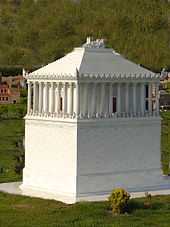Artemisia II of Caria
| Artemisia II | |
|---|---|
 Artemisia Prepares to Drink the Ashes of her Husband, Mausolus (c.1630) by Francesco Furini | |
| Satrap of Caria | |
| Reign | 353–351 BCE |
| Predecessor | Mausolus |
| Successor | Idrieus |
| Consort | Mausolus |
| House | Hecatomnids |
| Father | Hecatomnus |
Artemisia II of Caria (Greek Ἀρτεμισία; died 350 BCE) was the sister, the wife, and the successor of Mausolus, ruler of Caria, who was nominally the Persian satrap; Mausolus enjoyed the status of king or dynast of the Hecatomnid dynasty. After the death of her brother/husband, she reigned for two years, from 353 to 351 BCE. Her administration was conducted on the same principles as that of her husband; in particular, she supported the oligarchical party on the island of Rhodes.[1]
Life
_-_Artemisia.jpg)
She is renowned in history for her extraordinary grief at the death of her husband (and brother) Mausolus. She is said to have mixed his ashes in her daily drink, and to have gradually pined away during the two years that she survived him. She induced the most eminent Greek rhetoricians to proclaim his praise in their oratory; and to perpetuate his memory she built at Halicarnassus the celebrated Mausoleum at Halicarnassus, listed by Antipater of Sidon as one of the Seven Wonders of the Ancient World and whose name subsequently became the generic term for any splendid sepulchral monument.[2]
Polyaenus, in the eighth book of his work Stratagems, mentions that when Artemisia (he may have been referring to Artemisia I, but more probably Artemisia II) wanted to conquer Latmus, she placed soldiers in ambush near the city and she, with women, eunuchs and musicians, celebrated a sacrifice at the grove of the Mother of the Gods, which was about seven stades distant from the city. When the inhabitants of Latmus came out to see the magnificent procession, the soldiers entered the city and took possession of it.[3]

Other monuments
Another celebrated monument was erected by her in Rhodes to commemorate her conquest of the island. The Rhodians, after regaining their liberty, made it inaccessible, whence it was called in later times the Abaton (άβατον).[4]
Legacy in popular culture
Artemisia is referenced in the manga 12 Days by June Kim, about a woman who mourns her former girlfriend by drinking her ashes mixed with fruit smoothies. The great Scottish poet Robert Burns also made reference to Queen Artemisia in an epigram - Another [Epigram on the Said Occasion...On a Henpecked Country Squire] (1784).
Notes
- ↑ Diodorus Siculus, Bibliotheca, xvi. 36, 45; Demosthenes, Speeches, "On the liberty of the Rhodians", 11, 27
- ↑ Cicero, Tusculanae Disputationes, iii. 31; Strabo, Geography, xiv. 2; Aulus Gellius, Noctes Atticae, x. 18; Pliny, Natural History, xxv. 36, xxxvi. 4; Valerius Maximus, Facta et dicta memorabilia, iv. 6; Suda, s.v. "Artemisia", "Mausolos"
- ↑ Polyaenus: Stratagems- BOOK 8, 53.4 "Artemisia planted soldiers in ambush near Latmus; and herself, with a numerous train of women, eunuchs and musicians, celebrated a sacrifice at the grove of the Mother of the Gods, which was about seven stades distant from the city. When the inhabitants of Latmus came out to see the magnificent procession, the soldiers entered the city and took possession of it. Thus did Artemisia, by flutes and cymbals, possess herself of what she had in vain endeavoured to obtain by force of arms."
- ↑ Vitruvius, De architectura, ii. 8
References
- Smith, William (editor); Dictionary of Greek and Roman Biography and Mythology, "Artemisia (2)", Boston, (1867)
- Virginia Brown's translation of Giovanni Boccaccio’s Famous Women, pp. 115–118; Harvard University Press 2001; ISBN 0-674-01130-9
 This article incorporates text from a publication now in the public domain: Smith, William, ed. (1870). "article name needed". Dictionary of Greek and Roman Biography and Mythology.
This article incorporates text from a publication now in the public domain: Smith, William, ed. (1870). "article name needed". Dictionary of Greek and Roman Biography and Mythology.
External links
| Wikimedia Commons has media related to Artemisia II. |
- Artemisia by Jona Lendering